Engineering Management Final Year Project Report - Semester 4
VerifiedAdded on 2021/09/13
|5
|1038
|37
Report
AI Summary
This report details a student's final-year engineering project involving the design of a robot for home appliance control. The project required a team of ten members, with the student taking on the role of team leader. The report follows the STAR method (Situation, Task, Action, Result) to showcase the student's skills in team leadership, project management, and problem-solving. The student successfully managed team dynamics, ensured effective communication, and met project deadlines, including presenting the robot at a state-level technology workshop. The report highlights the research undertaken, including industry visits and workshops, and the successful application of problem-solving techniques in the robot's design. The report also includes a bibliography of relevant sources used during the project.
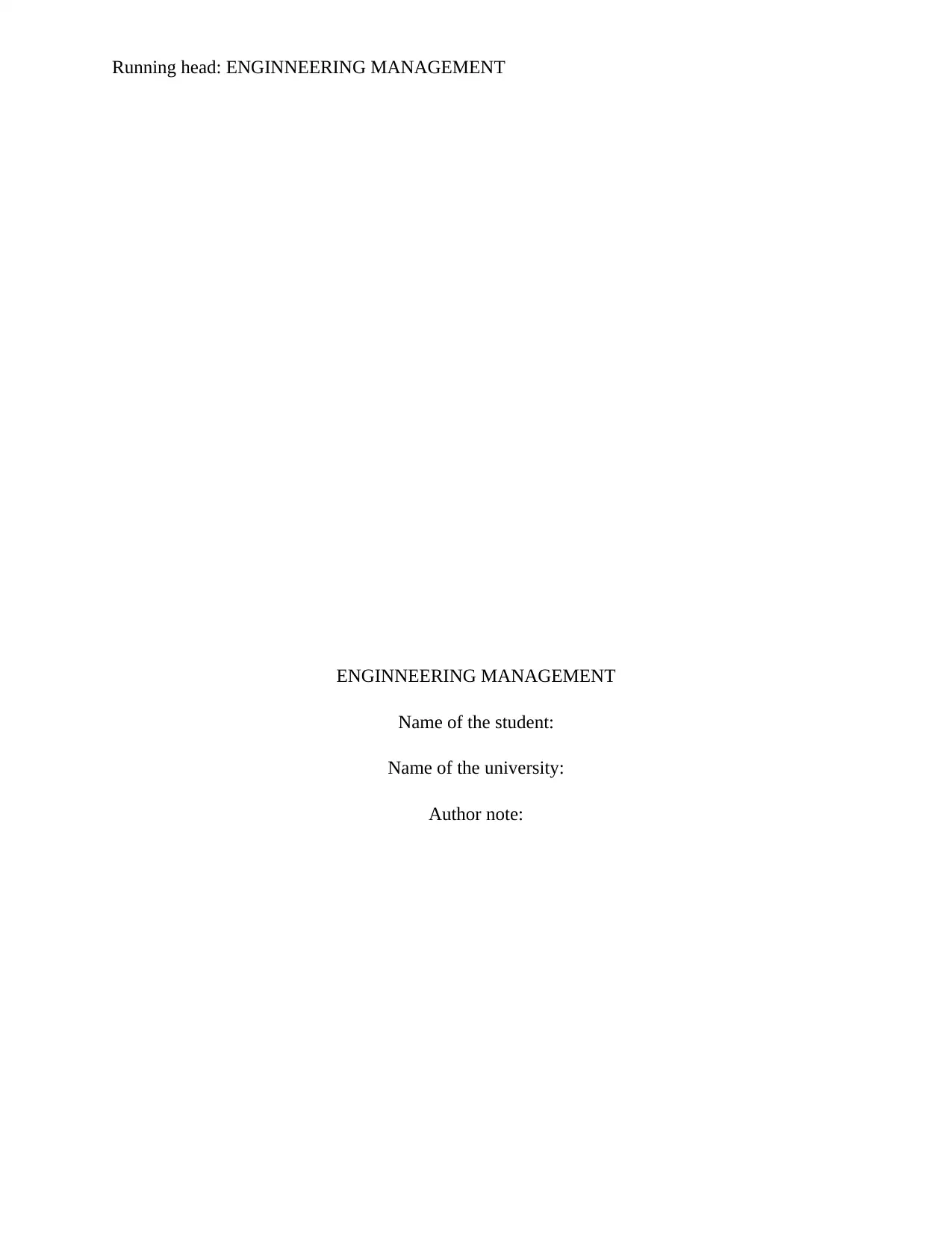
Running head: ENGINNEERING MANAGEMENT
ENGINNEERING MANAGEMENT
Name of the student:
Name of the university:
Author note:
ENGINNEERING MANAGEMENT
Name of the student:
Name of the university:
Author note:
Paraphrase This Document
Need a fresh take? Get an instant paraphrase of this document with our AI Paraphraser
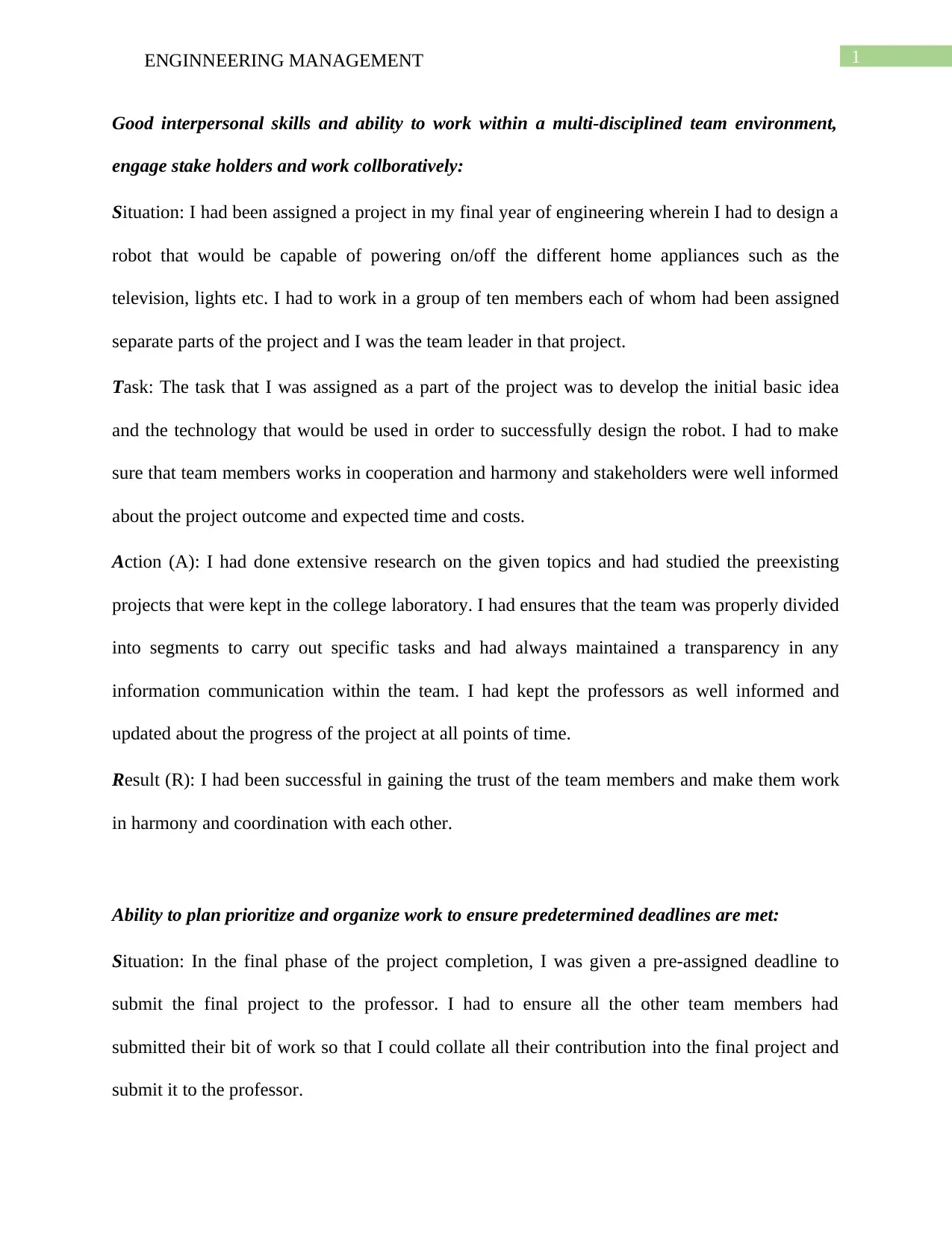
1ENGINNEERING MANAGEMENT
Good interpersonal skills and ability to work within a multi-disciplined team environment,
engage stake holders and work collboratively:
Situation: I had been assigned a project in my final year of engineering wherein I had to design a
robot that would be capable of powering on/off the different home appliances such as the
television, lights etc. I had to work in a group of ten members each of whom had been assigned
separate parts of the project and I was the team leader in that project.
Task: The task that I was assigned as a part of the project was to develop the initial basic idea
and the technology that would be used in order to successfully design the robot. I had to make
sure that team members works in cooperation and harmony and stakeholders were well informed
about the project outcome and expected time and costs.
Action (A): I had done extensive research on the given topics and had studied the preexisting
projects that were kept in the college laboratory. I had ensures that the team was properly divided
into segments to carry out specific tasks and had always maintained a transparency in any
information communication within the team. I had kept the professors as well informed and
updated about the progress of the project at all points of time.
Result (R): I had been successful in gaining the trust of the team members and make them work
in harmony and coordination with each other.
Ability to plan prioritize and organize work to ensure predetermined deadlines are met:
Situation: In the final phase of the project completion, I was given a pre-assigned deadline to
submit the final project to the professor. I had to ensure all the other team members had
submitted their bit of work so that I could collate all their contribution into the final project and
submit it to the professor.
Good interpersonal skills and ability to work within a multi-disciplined team environment,
engage stake holders and work collboratively:
Situation: I had been assigned a project in my final year of engineering wherein I had to design a
robot that would be capable of powering on/off the different home appliances such as the
television, lights etc. I had to work in a group of ten members each of whom had been assigned
separate parts of the project and I was the team leader in that project.
Task: The task that I was assigned as a part of the project was to develop the initial basic idea
and the technology that would be used in order to successfully design the robot. I had to make
sure that team members works in cooperation and harmony and stakeholders were well informed
about the project outcome and expected time and costs.
Action (A): I had done extensive research on the given topics and had studied the preexisting
projects that were kept in the college laboratory. I had ensures that the team was properly divided
into segments to carry out specific tasks and had always maintained a transparency in any
information communication within the team. I had kept the professors as well informed and
updated about the progress of the project at all points of time.
Result (R): I had been successful in gaining the trust of the team members and make them work
in harmony and coordination with each other.
Ability to plan prioritize and organize work to ensure predetermined deadlines are met:
Situation: In the final phase of the project completion, I was given a pre-assigned deadline to
submit the final project to the professor. I had to ensure all the other team members had
submitted their bit of work so that I could collate all their contribution into the final project and
submit it to the professor.
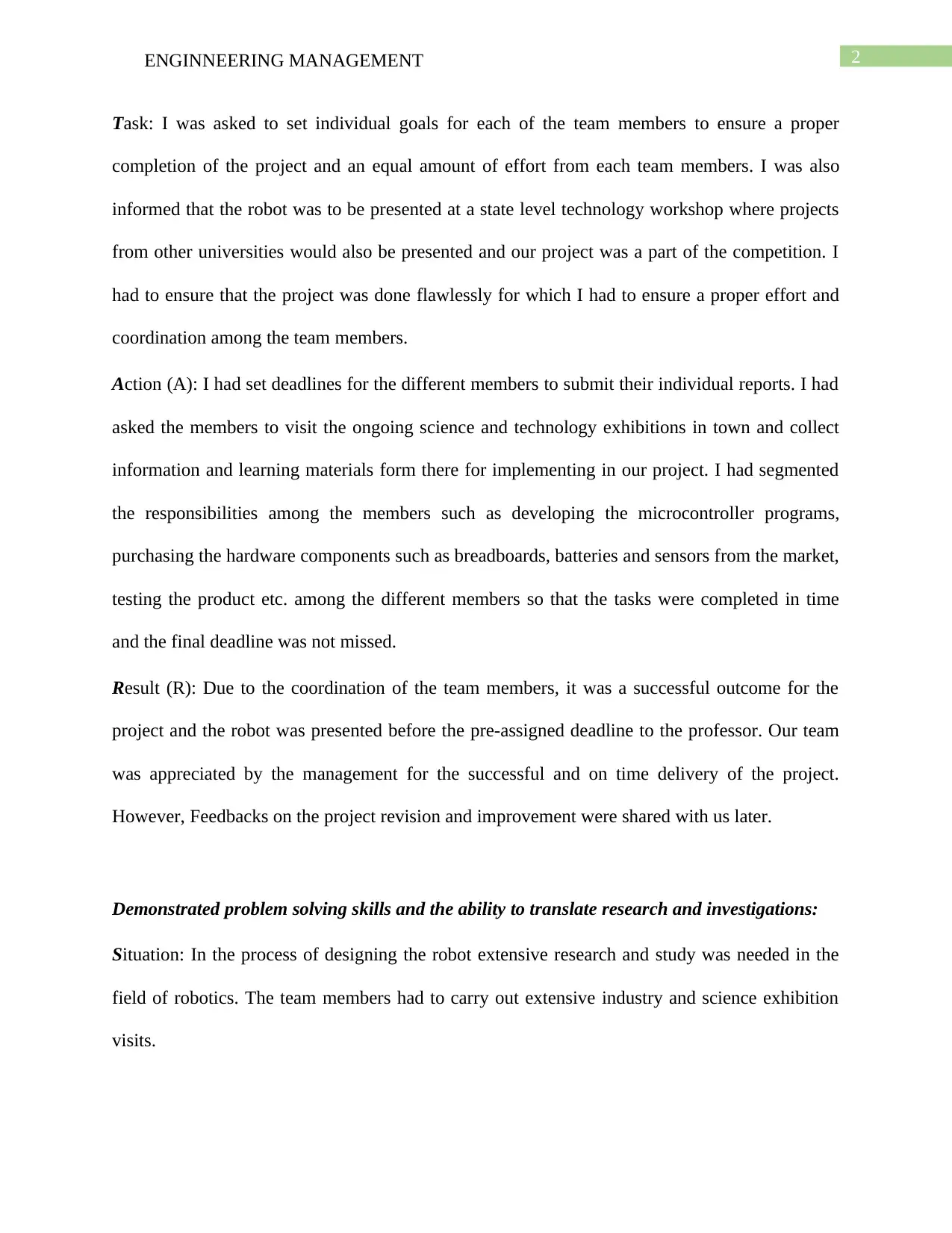
2ENGINNEERING MANAGEMENT
Task: I was asked to set individual goals for each of the team members to ensure a proper
completion of the project and an equal amount of effort from each team members. I was also
informed that the robot was to be presented at a state level technology workshop where projects
from other universities would also be presented and our project was a part of the competition. I
had to ensure that the project was done flawlessly for which I had to ensure a proper effort and
coordination among the team members.
Action (A): I had set deadlines for the different members to submit their individual reports. I had
asked the members to visit the ongoing science and technology exhibitions in town and collect
information and learning materials form there for implementing in our project. I had segmented
the responsibilities among the members such as developing the microcontroller programs,
purchasing the hardware components such as breadboards, batteries and sensors from the market,
testing the product etc. among the different members so that the tasks were completed in time
and the final deadline was not missed.
Result (R): Due to the coordination of the team members, it was a successful outcome for the
project and the robot was presented before the pre-assigned deadline to the professor. Our team
was appreciated by the management for the successful and on time delivery of the project.
However, Feedbacks on the project revision and improvement were shared with us later.
Demonstrated problem solving skills and the ability to translate research and investigations:
Situation: In the process of designing the robot extensive research and study was needed in the
field of robotics. The team members had to carry out extensive industry and science exhibition
visits.
Task: I was asked to set individual goals for each of the team members to ensure a proper
completion of the project and an equal amount of effort from each team members. I was also
informed that the robot was to be presented at a state level technology workshop where projects
from other universities would also be presented and our project was a part of the competition. I
had to ensure that the project was done flawlessly for which I had to ensure a proper effort and
coordination among the team members.
Action (A): I had set deadlines for the different members to submit their individual reports. I had
asked the members to visit the ongoing science and technology exhibitions in town and collect
information and learning materials form there for implementing in our project. I had segmented
the responsibilities among the members such as developing the microcontroller programs,
purchasing the hardware components such as breadboards, batteries and sensors from the market,
testing the product etc. among the different members so that the tasks were completed in time
and the final deadline was not missed.
Result (R): Due to the coordination of the team members, it was a successful outcome for the
project and the robot was presented before the pre-assigned deadline to the professor. Our team
was appreciated by the management for the successful and on time delivery of the project.
However, Feedbacks on the project revision and improvement were shared with us later.
Demonstrated problem solving skills and the ability to translate research and investigations:
Situation: In the process of designing the robot extensive research and study was needed in the
field of robotics. The team members had to carry out extensive industry and science exhibition
visits.
⊘ This is a preview!⊘
Do you want full access?
Subscribe today to unlock all pages.

Trusted by 1+ million students worldwide
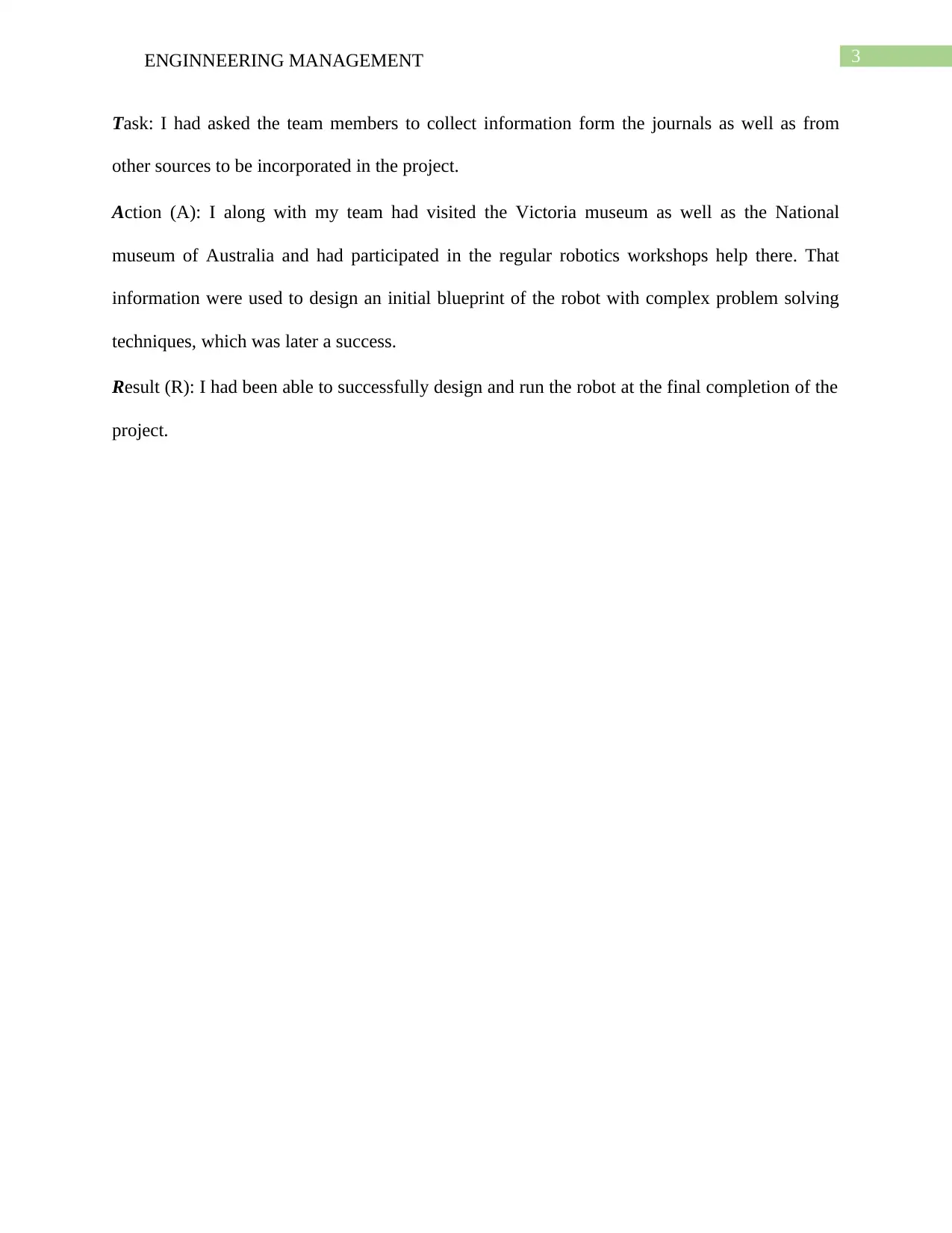
3ENGINNEERING MANAGEMENT
Task: I had asked the team members to collect information form the journals as well as from
other sources to be incorporated in the project.
Action (A): I along with my team had visited the Victoria museum as well as the National
museum of Australia and had participated in the regular robotics workshops help there. That
information were used to design an initial blueprint of the robot with complex problem solving
techniques, which was later a success.
Result (R): I had been able to successfully design and run the robot at the final completion of the
project.
Task: I had asked the team members to collect information form the journals as well as from
other sources to be incorporated in the project.
Action (A): I along with my team had visited the Victoria museum as well as the National
museum of Australia and had participated in the regular robotics workshops help there. That
information were used to design an initial blueprint of the robot with complex problem solving
techniques, which was later a success.
Result (R): I had been able to successfully design and run the robot at the final completion of the
project.
Paraphrase This Document
Need a fresh take? Get an instant paraphrase of this document with our AI Paraphraser
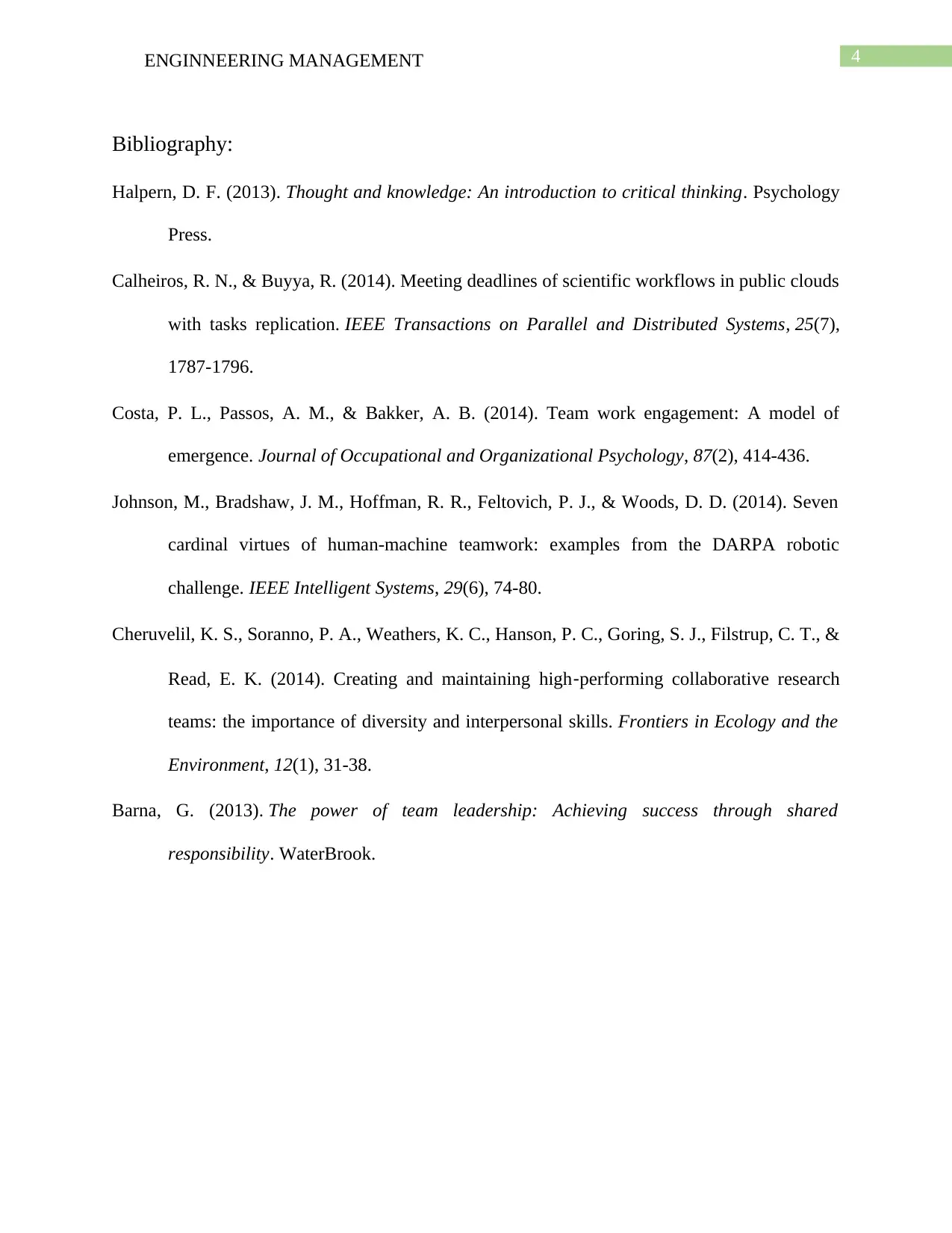
4ENGINNEERING MANAGEMENT
Bibliography:
Halpern, D. F. (2013). Thought and knowledge: An introduction to critical thinking. Psychology
Press.
Calheiros, R. N., & Buyya, R. (2014). Meeting deadlines of scientific workflows in public clouds
with tasks replication. IEEE Transactions on Parallel and Distributed Systems, 25(7),
1787-1796.
Costa, P. L., Passos, A. M., & Bakker, A. B. (2014). Team work engagement: A model of
emergence. Journal of Occupational and Organizational Psychology, 87(2), 414-436.
Johnson, M., Bradshaw, J. M., Hoffman, R. R., Feltovich, P. J., & Woods, D. D. (2014). Seven
cardinal virtues of human-machine teamwork: examples from the DARPA robotic
challenge. IEEE Intelligent Systems, 29(6), 74-80.
Cheruvelil, K. S., Soranno, P. A., Weathers, K. C., Hanson, P. C., Goring, S. J., Filstrup, C. T., &
Read, E. K. (2014). Creating and maintaining high‐performing collaborative research
teams: the importance of diversity and interpersonal skills. Frontiers in Ecology and the
Environment, 12(1), 31-38.
Barna, G. (2013). The power of team leadership: Achieving success through shared
responsibility. WaterBrook.
Bibliography:
Halpern, D. F. (2013). Thought and knowledge: An introduction to critical thinking. Psychology
Press.
Calheiros, R. N., & Buyya, R. (2014). Meeting deadlines of scientific workflows in public clouds
with tasks replication. IEEE Transactions on Parallel and Distributed Systems, 25(7),
1787-1796.
Costa, P. L., Passos, A. M., & Bakker, A. B. (2014). Team work engagement: A model of
emergence. Journal of Occupational and Organizational Psychology, 87(2), 414-436.
Johnson, M., Bradshaw, J. M., Hoffman, R. R., Feltovich, P. J., & Woods, D. D. (2014). Seven
cardinal virtues of human-machine teamwork: examples from the DARPA robotic
challenge. IEEE Intelligent Systems, 29(6), 74-80.
Cheruvelil, K. S., Soranno, P. A., Weathers, K. C., Hanson, P. C., Goring, S. J., Filstrup, C. T., &
Read, E. K. (2014). Creating and maintaining high‐performing collaborative research
teams: the importance of diversity and interpersonal skills. Frontiers in Ecology and the
Environment, 12(1), 31-38.
Barna, G. (2013). The power of team leadership: Achieving success through shared
responsibility. WaterBrook.
1 out of 5
Related Documents
Your All-in-One AI-Powered Toolkit for Academic Success.
+13062052269
info@desklib.com
Available 24*7 on WhatsApp / Email
![[object Object]](/_next/static/media/star-bottom.7253800d.svg)
Unlock your academic potential
Copyright © 2020–2025 A2Z Services. All Rights Reserved. Developed and managed by ZUCOL.




